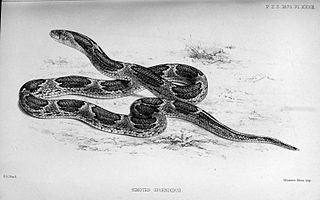
Oligodon is genus of colubrid snakes that was first described by Austrian zoologist Leopold Fitzinger in 1826. This genus is widespread throughout central and tropical Asia. The snakes of this genus are commonly known as kukri snakes.

The streaked kukri snake is a species of nonvenomous snake found in Asia. It is also known as the variegated kukri. The IUCN lists the species as least concern.

Oligodon cinereus, the ashy kukri snake or Günther's kukri snake, is a species of snake in the family Colubridae.
Oligodon theobaldi, commonly known as the Mandalay kukri snake or Theobald's kukri snake, is a species of snake in the family Colubridae. The species is endemic to Asia.

Lycodon is a genus of colubrid snakes, commonly known as wolf snakes. The Neo-Latin name Lycodon is derived from the Greek words λύκος (lykos) meaning wolf and οδόν (odon) meaning tooth, and refers to the fang-like anterior maxillary and mandibular teeth. They are nonvenomous, but many members of this genus strongly resemble the venomous kraits in appearance, an example of Emsleyan mimicry.

Eirenis barani, also known commonly as Baran's dwarf racer, is a species of snake in the family Colubridae. The species is endemic to the Near East.

The black-headed ground snake, also known as the Palestine kukri snake is a species of small and elegant harmless snake, which is endemic to the Eastern Mediterranean and the Near East. It belongs to the Colubridae family. Two subspecies, Rhynchocalamus melanocephalus melanocephalus and Rhynchocalamus melanocephalus satunini, are currently recognized.

Aspidura is a genus of snakes in the subfamily Natricinae of the Family Colubridae. The genus is endemic to island of Sri Lanka. Member species are commonly known as rough-sided snakes, except for A. ceylonensis, which is commonly known as the black-spined snake and was formerly in the genus Haplocercus. The genus Aspidura comprises nine species, with the latest having been discovered in 2019.
Oligodon moricei, commonly known as Morice's kukri snake, is a species of snake in the family Colubridae. The species is endemic to southern Vietnam.

Oligodon deuvei is a species of snake in the family Colubridae. The species is endemic to Southeast Asia.
Oligodon pseudotaeniatus, commonly known as the false striped kukri snake, is a species of colubrid snake. It is endemic to Thailand and known from the Nakhon Ratchasima Province, Saraburi Province, and Bangkok. The type series was collected by Malcolm Arthur Smith. The specific name pseudotaeniatus refers to its similarity to Oligodon taeniatus, with whom it was confused prior to its species description in 2008.
Oligodon annamensis, commonly known as the Annam kukri snake or Leviton’s kukri snake, is a species of colubrid snake originally known from two specimens from Vietnam, where it was thought to be endemic. It has also since been found in Cambodia and Thailand.
Macrocalamus is a genus of snakes of the family Colubridae.
Muhtarophis barani, also known commonly as Baran's black-headed dwarf snake, is a species of snake in the monotypic genus Muhtarophis in the subfamily Colubrinae of the family Colubridae. The species is endemic to the Amanos Mountains of Turkey, and was discovered in 2007.

Oligodon huahin, the Hua Hin kukri snake, is a species of kukri snakes in the genus Oligodon. The species was first discovered and described in late 2016, and the article was published July 13, 2017. It is only known from its type locality but its range is likely to be more extensive. O. huahin is thought to be very secretive, similar to other species of the genus Oligodon. This theory is supported by the type specimen, which all were males, suggesting that it was found during the mating season where males are out and actively search for females to reproduce. This may also explain why this species had not yet been discovered

Oligodon fasciolatus, commonly known as the small-banded kukri snake or the fasciolated kukri snake, is a species of snake in the family Colubridae. The species is native to Southeast Asia. This snake uniquely eviscerates live poisonous toads, Duttaphrynus melanostictus, to avoid toxic white liquid the toad secretes.

Oligodon splendidus, commonly known as the splendid kukri snake, is a species of snake of the family Colubridae.
Rhynchocalamus arabicus, the Aden kukri snake, is a species of snake of the family Colubridae.

Rhynchocalamus satunini, the Palestine kukri snake, is a species of snake of the family Colubridae.











